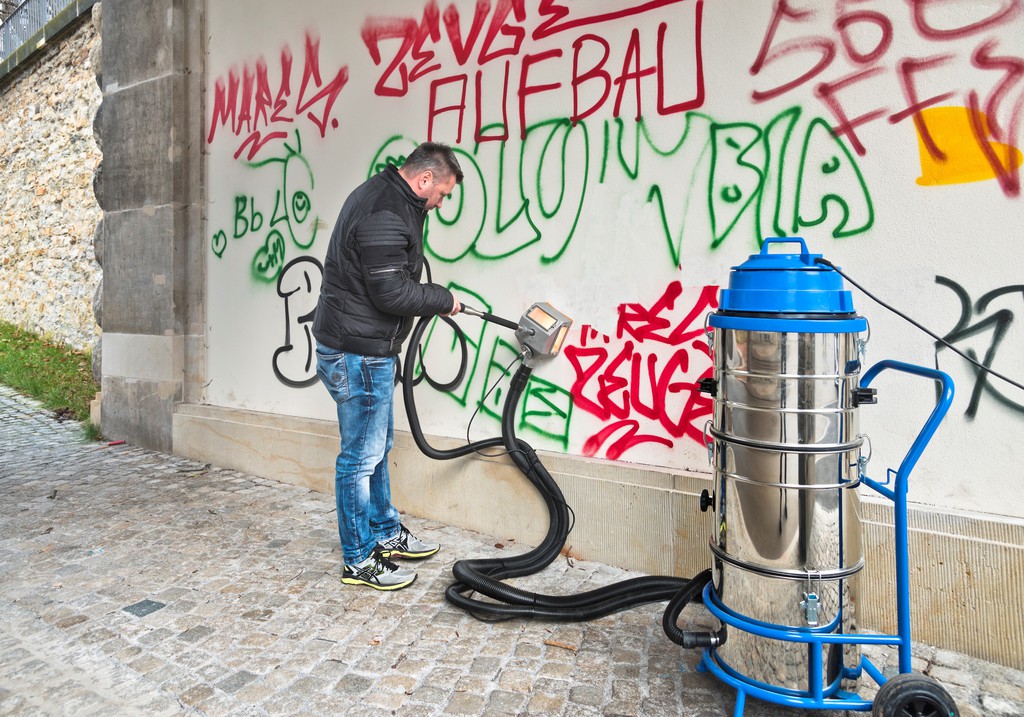

|
Chris Shaw
Editor |
| Home> | FACILITIES MANAGEMENT | >Graffiti Removal & Control | >Graffiti removal gets greener |
| Home> | SUSTAINABILITY | >Green Cleaning Methods | >Graffiti removal gets greener |
Graffiti removal gets greener
05 December 2018
The latest graffiti removal methods are becoming more environmentally-friendly – without compromising on performance, argues cleaning equipment manufacturer systeco.

Is graffiti art or is it just an act of plain vandalism? Opinions on this differ greatly. However, the fact is that the name of the artist is seldom known and the cost of removing unwanted drawings, texts or symbols is usually borne by the community at large or by the owner of the object.
Pressure cleaning using chemicals
Classical graffiti removal methods, such as pressure cleaning, often use chemicals where the graffiti is pre-soaked using chemical detergents that deeply penetrate the substrate and break down the ink or paint. This is rounded off by pressure cleaning the substrate.
However, pressure cleaning can damage the substrate – with sandstone particularly affected. The process can penetrate up to 3 or 4 centimetres into the stone. And the paint or ink residues can still be seen afterwards because they are driven straight into the pores.
Most people assume that the chemical cleaning materials are collected and tidied up after use. And in fact, that is also a legal requirement. But many service providers do not catch the waste water and the authorities do not check this adequately.
Dry ice, laser technology or steam
Dry ice is also often used, or only high-pressure cleaning. But in our opinion, the high-pressure method is more suitable for use on concrete and can leave deep scratches, as might happen with sandblasting. On the other hand, the dry ice process can be too price-intensive and also affects the subsurface too much. This method is also not sufficiently eco-friendly, especially given the level of resources its production requires.
Two less harmful, but rarely applied, methods are laser technology, where the ink or paint particles are dissolved without penetrating the substrate, and the steam method. But one of our key customers, German graffiti removal service provider Graffiti Stop, has found these processes to be cumbersome to use and not efficient enough.
Granulate-based vacuum-blasting method
Instead, Graffiti Stop opted for our Tornado ACS system. Since then, the company has only used this eco-friendly vacuum blasting process on a granulate basis to remove graffiti from all surfaces. Entirely chemical-free and without using high pressure, the equipment can be individually tuned to each surface through the choice of granulate and by adjusting the drive power, and can be used both indoors and outdoors.
The granulate can be reused up to 80 times and is not harmful to the environment or the sub-surface. Because of this 'soft' procedure, the vacuum blasting system is also suitable for use on and in historic buildings. Depending on what the operator or the owner indicates, the removal of graffiti can be done so that it preserves the patina of the substrate or the stone can be cleaned deep into the pores, so that it looks like new.
Lead-containing or other toxic ink or paint is also collected by the vacuum-blasting system in a closed circuit and filtered to be disposed of separately afterwards. The equipment works without moisture and is suitable for mobile use. Since no dust is generated and no waste water or the like has to be removed, application during the normal use of the object is possible.
Lars Kühnel, managing director of Graffiti Stop, said: "We are eco-friendly and employee-friendly, that is, we do not impose high demands or stressful situations on our staff. Hearing, visual or respiratory protection is not necessary with our system and there is no hard physical labour involved."
Depending on the number of layers of paint or ink, one device has a capacity of 2 to 5 m2 per hour. And, according to Lars Kühnel, the operating costs are very low. "The staff are still the highest cost item. The device itself is very efficient: we only have power, generator (diesel) and granulate costs."
systeco believes that the combination of environmental protection and sustainability is the most important trend within current public opinion concerning graffiti removal. Public authorities and large companies in particular are increasingly requiring sustainability. And, encouragingly, lots of other customers are attaching greater importance to the process itself and not just the price.
- Chemical free attraction
- More water efficient scrubber dryers on ECA scheme
- Council cleaners go bleach free to green up Liverpool
- Green at source
- Scheme saves water, saves money, saves tax
- Ioning out chemicals in cleaning
- Wipe out waste with contaminated wipes laundry service
- Companies partner for green paper drive
- Good reaction to environmental best practice awar
- A cool half






















